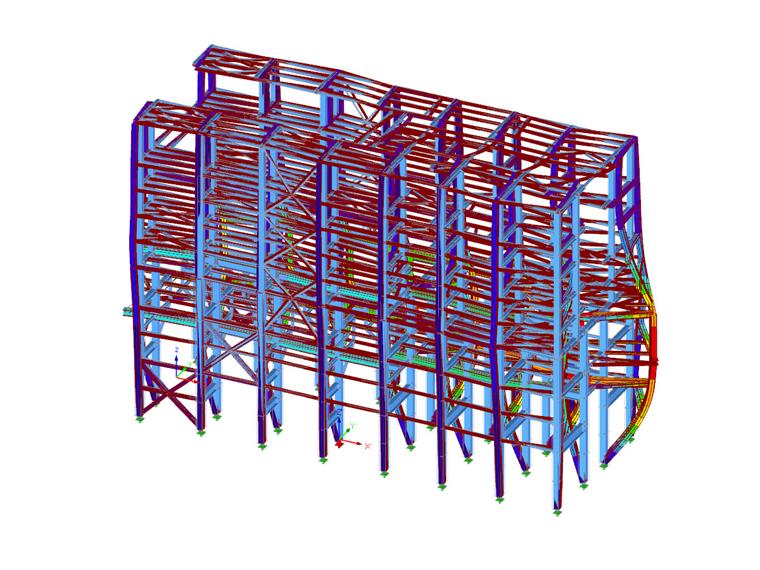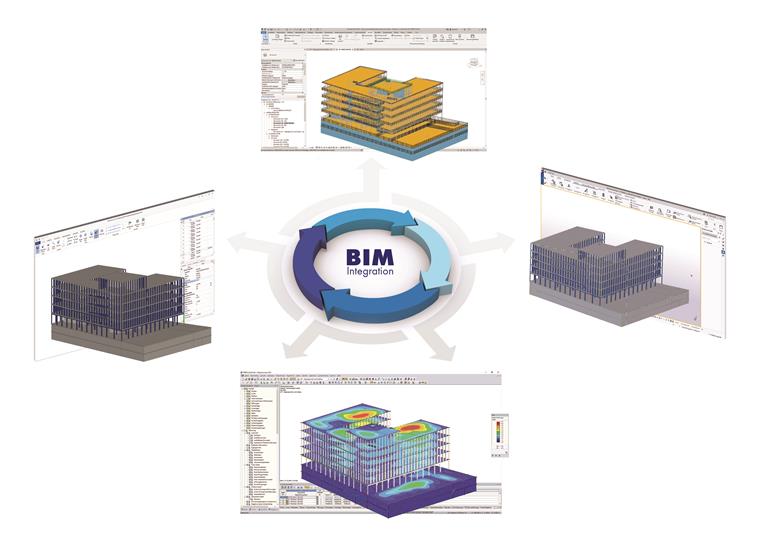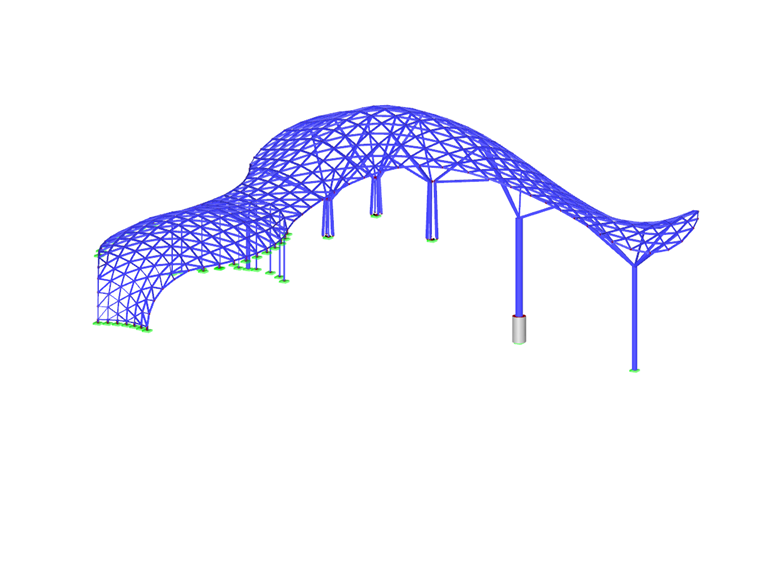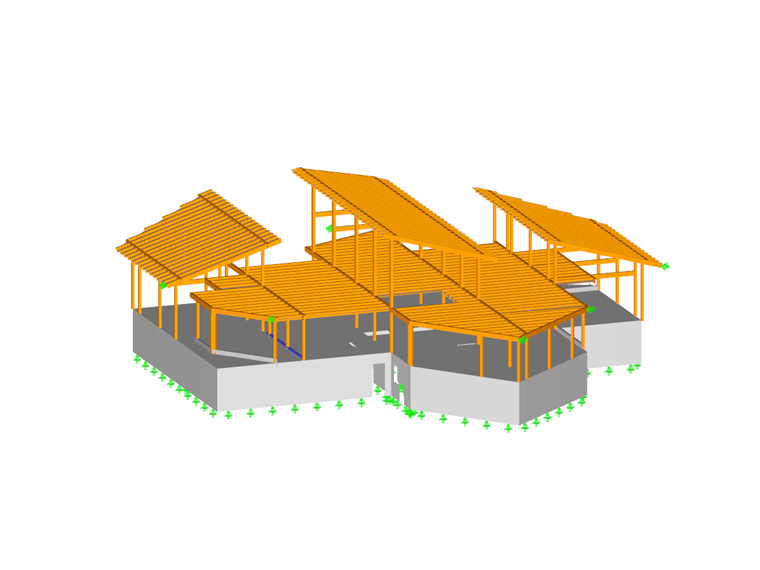Structural Concept and Stability
When starting a construction project, you have to consider how a structure should work. Issues arise such as the maximum possible distances of columns and beams, the positions of roof and wall bracings, and the execution of the foundations. You have to create the supporting structure of the building.
Even for buildings that seem to have a simple structure, questions may arise as to whether you need stiffening elements or how you can arrange them in an optimal way. The work in the floor plan, view, and section does not really simplify the understanding of the load transfer and the load paths. Finally, a 3D model helps you to get a better idea where the forces are and where they are transferred to the foundations. Understanding the function of the structure is, therefore, the basis for efficient planning of the entire structure. The detection of stability deficits is additionally relevant for safety reasons.
In a simplified, planar 2D model, stability issues such as buckling from the plane or simple overturning are excluded by definition. Such problems do not occur during the calculation and can, therefore, be overlooked. In the case of three-dimensional calculations, the structural engineer is forced to consider spatial failure mechanisms. Thus, errors in the structural design are inevitably revealed during the calculation in most cases.
In a 3D model, you can, therefore, better evaluate a global stability failure on the entire model.
Building Information Modeling Providing 3D Models
The use of modern planning methods such as Building Information Modeling is based on 3D models. These also form the basis of structural analysis and design and can provide well-idealized input models for the calculation. The 3D model for the structural analysis and design is thus already included in the ideal case and you can save time.
For many cases of a preliminary design or simple structural evaluation to find the right structure, this can be a very quick and helpful method. Another trend is towards fully parametric design planning, where the structural analysis is completely coupled with the architectural software. By specifically modifying parameters, you can check and automatically calculate many options.
2D Insufficient for All Structures and Building Types
If the building cannot be divided easily into substructures where the load transfer is clear, there is often no other way than to use a 3D model. Not every building follows a regular grid. This makes the load transfer complicated and difficult to control. Since there are uncertainties, we work with maximum load assumptions in order to be on the safe side. However, this leads to uneconomical results.
Clearer and Easier Simulation of Actions on Entire Model
3D calculation programs can automatically generate loads for actions such as self-weight, wind, and snow for standardized building shapes. The prerequisite is that you know the dimensions of the building. If you use entire models, you can derive these dimensions easily from the model. You can apply wind and snow load profiles to the structure automatically. When changing the geometry, the loads change automatically. Simulations in a digital wind tunnel are only possible with 3D models.
Often Insufficient Dynamic Analysis of 2D Models
When performing seismic calculations or other dynamic analyses, spatial mode shapes occur that you have taken into account.
In the same way, you have to superimpose seismic excitations in the x- and y-directions accordingly. Accidental torsional loads play a role. Therefore, you can only avoid using 3D models in the simplest cases.
Flexibility for Changes
The planning process is marked by changes. For the construction process, it is important that you always know what is possible in structural analysis and design, and what you have to change. In traditional structural analysis, this may mean that all load assumptions have to be reconsidered.
In the case of a complete 3D structural model, the changing forces are automatically included in the system and transferred from component to component. When performing a new calculation, all designs are updated. The initially possibly higher input effort is usually compensated.
Problematic Support Conditions When Creating Partial Models
When extracting partial models from the overall model, you have to assign support definitions to the connection points of the partial model. Since the stiffnesses in these connection points are not known in most cases or can only be determined with difficulty, hinged or rigid supports are used for simplification. These assumptions are only partially correct and inevitably lead to different results compared to models that obtain the stiffnesses at these connecting points from the overall model.
Detailed Structural Analysis only Useful as 3D Model
The use of 3D shell models, for example in the design of steel connections, is state of the art. Without a 3D solution, such analyses would not be possible. In these application cases, using 3D models is not questioned at all, but is actually required. Therefore, it is incomprehensible why 3D calculations should not be used for the calculation of entire buildings.
3D World Side Effects
In many cases, a 3D calculation model illustrates the result much more clearly than a number of smaller partial models. You can better understand the structural behavior, for example, with visualized representations of deformations, stresses, and forces.
These models also provide a professional impression on the parties involved and ensure the good reputation of the structural engineer. You can also use these models for initial mass determinations and cost estimates. Due to the mentioned flexibility, you can optimize shape, function, and weight.
Summary
There are many reasons we recommend using 3D models in structural analysis and design. However, 2D and 3D do not compete with, but complement, each other. Of course, there are also simple cases where a 3D model has no advantages and determines the correct results. In both cases, it is the engineer who decides which modeling to choose.




